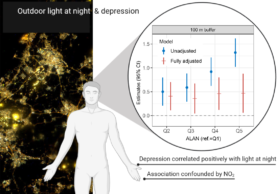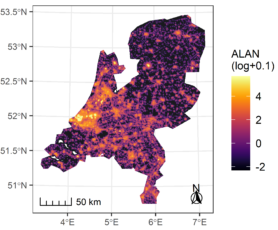News
Outdoor light at night, air pollution and depressive symptoms

Background: Artificial light at night (ALAN) may be an anthropogenic stressor for mental health disturbing humans’ natural day–night cycle. However, the few existing studies used satellite-based measures of radiances for outdoor ALAN exposure assessments, which were possibly confounded by traffic-related air pollutants.
Objective: To assess 1) whether living in areas with increased exposure to outdoor ALAN is associated with depressive symptoms; and 2) to assess the potential confounding effects of air pollution.
Methods: We used cross-sectional data from people (N=10,482) aged 18-65 years in the Netherlands. Depressive symptoms were assessed with the Patient Health Questionnaire (PHQ–9). Satellite-measured annual ALAN were taken from the Visible Infrared Imaging Radiometer Suite. ALAN exposures were assessed at people’s home address within 100 and 600 m buffers. We used generalized (geo)additive models to quantify associations between PHQ–9 scores and quintiles of ALAN adjusting for several potential confounders including PM2.5 and NO2.

Findings: Unadjusted estimates for the 100 m buffers showed that people in the 2nd to 5th ALAN quintile showed significantly higher PHQ–9 scores than those in the lowest ALAN quintile (βQ2=0.503 [95% confidence interval, 0.207-0.798], βQ3=0.587 [0.291-0.884], βQ4=0.921 [0.623-1.218], βQ5=1.322 [1.023-1.620]). ALAN risk estimates adjusted for individual and area-level confounders (i.e., PM2.5, urbanicity, noise, land-use diversity, greenness, deprivation, and social fragmentation) were attenuated but remained significant for the 100 m buffer (βQ2=0.420 [0.125-0.715], βQ3=0.383 [0.071-0.696], βQ4=0.513 [0.177-0.850], βQ5=0.541 [0.141-0.941]). When adjusting for NO2 per 100 m buffers, the air pollutant was associated with PHQ–9 scores, but ALAN did not display an exposure-response relationship. ALAN associations were insignificance for 600 m buffers.
Interpretation: Accounting for NO2 exposure suggested that air pollution rather than outdoor ALAN correlated with depressive symptoms. Future evaluations of health effects from ALAN should consider potential confounding by traffic-related exposures (i.e., NO2).

